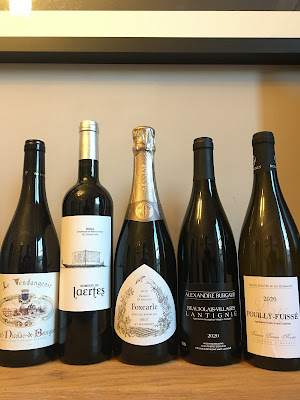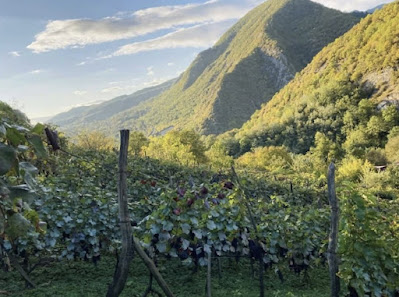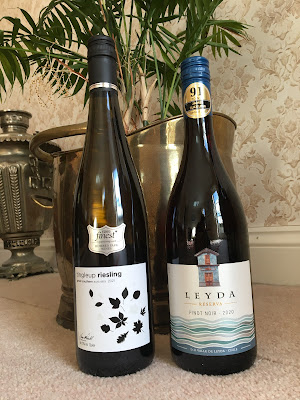Sunday 27 March 2022
Contemporary Georgia
Saturday 26 March 2022
The CWB Spain-Off
Thursday 24 March 2022
Food and Wine Matching with Kindling Restaurant - White Chocolate Fudge with Dark Chocolate Crumb
Friday 18 March 2022
The CWB Eastern France-Off - A Deeper Dive
Draw a straight line down the Eastern side of France from the English Channel to the Mediterranean and you will pass through three great wine regions; Champagne, Burgundy and the Rhône.
It is around 800 miles end-to-end, and can be a pleasant drive to sunnier climes if you add in a stop-over - lunch in Reims, dinner somewhere between Dijon and Macon then an onward drive the following day to the Rhône, Provence or Côte d'Azur for a week of R&R.
We have done it many times over the years with the children and like to mix up the journey with various scenic detours, including, on one occasion, a side-trip to Chablis.
Visiting a wine region and spending time there is the best way I have found to understand its geography, terroir, history, gastronomy as well as the sources of its diversity.
So, in anticipation of a long European summer drive south to sun-kissed beaches and shimmering seas, here is a deeper dive in to a few regions along the way.
Chablis
At the the far north of Burgundy, Chablis is perhaps better understood as a southerly outpost of Champagne.
Chablis has four levels of classification from Petit up to Grand Cru. Premier Cru is, somewhat confusingly, the second rank of wines, tending to be well structured and long, but needing 5-10 years of ageing to show their best.
There are 40 Premier Cru sites scattered across the appellation, with 17 main ‘Climats’.
Chardonnay is the only permitted grape across the region so there is a distinct Chablis flavour profile - lean and steely in its youth, golden and complex with age.
Vintage aside, the differences are more about quality as a result of location, aspect and soil type - and prices charged will reflect this, of course.
At Premier Cru level, a key distinction is Left Bank vs Right Bank; the Left Bank of the Serein River is cooler giving steelier wines that benefit more from ageing, whereas the Right Bank tends to produce fuller, richer, more powerful wines that are more expressive and approachable when younger.
Here, we have two younger left bankers and a right bank Premier Cru Chablis with more age.
The age vs bank dynamic accentuates the differences in the wines; the older Right Bank wine is showing better right now and for immediate drinking would be my recommendation.
However, with an eye on the future, you should also consider the two Left Bankers and tuck them away somewhere dark and cool, then dig them out in several years and consider what an excellent investment you made.
Simonnet-Febvre Chablis Premier Cru Montmains 2020 (WaitroseCellar.com: £25.49, Great Grog: £32.29, FL Dickins, Thedrinkshop.com: £28.54)
This is from the left bank which faces southeast, enjoying the morning sun, but it is colder and windier throughout the day, meaning the wines are often more restrained and emphasising classic minerality.
Wines from Montmains are more mineral than fruit driven, because of the stony minerality from the chalk soils.
This has a mineral touch and is powerful with predominant aromas of flowers. It is a supple and rounded wine which has a real sense of its terroir.
restrained orchard fruits and citrus; orchard and white stone fruits, delicate florality and hints of honeysuckle with saline minerality; fresh, supple and pure.
Drinks well on first opening, but better to aerate and also preferably cellar for several years to allow it to develop and show its best.
Very Good.
Match with fish in sauce or white meats.
Simonnet-Febvre Premier Cru Vaillons 2019 (WaitroseCellar.com (£28.99), Small Beer, Whole Foods Market, Thedrinkshop.com (£28.91))
This wine enjoys soils on the left bank that are less clay-like than those on the right bank. Vaillons is one of the largest and well-known of the Chablis Premiers Crus and this wine is an excellent example of a highly rated left bank Chablis.
Pure and focused, it has aromas of delicate white flowers and fruit. Well-rounded and charming this wine has a note of minerality on the palate and a good balance between acidity and fruit.
A generous, beautifully balanced wine with good length and very typical of Chablis.
fresh zippy citrus and delicate florality; orchard and white stone fruits with saline minerality, white pepper and a savoury leesiness; elegant, precise and poised.
Drinks nicely on first opening, but will improve with cellaring and some aeration.
Very Good.
Drink with seafood, grilled fish and white meats in sauce.
Simonnet-Febvre Premier Cru Fourchaume 2018 (Tesco: £25-£30, Thedrinkshop.com: £31.99)
This is from the Right Bank which tends to produce richer and more powerful wines.
The Fourchaume vineyard borders the northern limits of the town of Chablis and is one of the most well-known and highly respected crus, with a reputation for generosity of flavours. Exposed to the west and southwest, the area sees many hours of sunshine and being downstream, it benefits from the rich terroir created from the alluvium carried by the river. The grapes from the vines here have an average age of 30 years.
Aged on lees, in stainless steel, for 10-12 months, this is classically elegant, powerful, and round with lovely aromas of citrus fruit, fresh mint and spicy notes alongside ripe fruits and honey flavours.
honeysuckle and yellow stone fruits with white pepper and herbaceous mint; full and supple with saline minerality; stone fruits, honey and savoury, creamy brazil nut leesiness.
Very Good.
Match with fruits de mer, lobster, oysters, clams, prawns, or pork medallions in a cream-and-mushroom sauce.
Northern Rhône
Drive past Lyon and out of Burgundy and, as the mercury rises, you start heading head towards the dusty, rocky, lavender-scented region of Provence via the Rhône valley.
The Northern Rhône is Syrah's spiritual home and predominantly a red-wine area.
Saint-Péray, then, is something of an anomaly; small and little-known, it is an exclusively white region, producing mainly sparkling wines that were once more highly-regarded than Champagne.
Oenologically, it dates back to Roman times, grows mainly Roussanne and was apparently Napoleon's first taste of wine as a Cadet in nearby Valence.
UK Rhône expert Matt Walls says of the region: stylistically, it is most similar to St. Joseph. It has both granite and limestone soils, so the specific wine style depends on where the vines are planted, but it’s usually marginally softer than a typical St Joseph. It can be lovely
US-based Jeb Dunnuck adds: it's more limestone soils as opposed to granite soils; the wines rarely seem to have the density of a top Hermitage or Saint Joseph, but always seem to shows a terrific sense of minerality as well as salinity. Most great Hermitage Blancs come from the more limestone and loess soils on the eastern part of the hill, so there are some similarities from a soil standpoint, but Saint-Péray is more east-facing, so it doesn't have the incredible exposure of Hermitage.
This wine is an anomaly within an anomaly; neither sparkling nor made from Roussanne. It is also very impressive.
Saint-Péray 2020, Vidal-Fleury
Made from 100% Marsanne grown on granitic soil covered with silt, lœss and limestone debris. The wine is fermented in stainless steel tanks and and aged 30% in oak barrels and 70% in stainless steel on the lees with some batonnage.
bright yellow and green with white flowers, lemon zest and subtle hawthorn, violet, and acacia with hints of honey; sweet lemon, apricot, pear and creamy-leesy almond with aromatic fennel, white pepper and aniseed; rounded, decadent and long yet fresh.
Very Good
Match with fish, white meat or regional cheese.
Southern Rhône
Hedonistic where the North can be haughty, the Southern Rhône is home to a wider range of grapes, colours and styles of wine.
Sunday 13 March 2022
Is This It? Hungarian Pinot Blanc from The Co-op
Saturday 12 March 2022
Yalumba Y Series
Tuesday 8 March 2022
Easter Wines from Virgin Wines - The Old World
Sunday 6 March 2022
Georgia - Masterclass with Sarah Abbott
A small country of just 4 million people, physically it is the same size as Scotland, surrounded by much larger neighbours and forms a land bridge between the Black Sea and the Caspian Sea.
On a southerly, sub-tropical latitude, temperatures are moderated by the effects of the Black Sea to the East and shielded from cold air by the Caucasus Mountains to the North.
Georgia's continued existence in the midst of larger, sometimes aggressive empires is a testament to the sheer resilience of its people and their strong sense of identity; it is one the cradles of civilisation and one of the earliest Christian nations.
Climatically, the East is warmed by air from Iran whereas the West Coast is sub-tropical with a warm, benign, year-round climate with high humidity and high average annual temperatures of around 20C. Inland, the altitude of the mountains brings a more varied climate and this diversity is what has attracted potential conquerors over the centuries.
The vineyards can be at elevations of 400m to 700m+; historically, many of the (better) higher-altitude vineyards were abandoned under the Soviet regime, with its focus on low-cost quantity over quality.
Regions:
Kakheti in the South East corner, one of the warmest, sunniest, driest areas and accounts for almost 3/4 of all wines, which tend to be bigger, riper and more full-bodied
Kartli a breezy region in the middle of the country, an increasingly important region, the wines here are more aromatic
Imereti home to the former capital of Georgia and a major tourist destination, it has a long history and culture; more cut-off than Kakheti, it was less influenced by Soviet collective practices and now has a large number of small boutique wineries in a patchwork of highly-fragmented smallholdings that survived through the Soviet period due to its remoteness; parcels of rarer varieties and old vines
Racha and Lechkuni two beautiful emerging areas, high up in the foothills of the Caucasus, they specialise in bright mountain reds with a unique nervy, scented style; Racha is a national park
Meskheti on the Turkish border and historically occupied by the Ottomans, it has an interrupted history of winemaking
Guria sub-tropical and hazy-humid with mountains rising from the sea, the vineyards are at altitude and grapes picked as late as November but still maintain acidity; wine here is a monastic tradition
Grapes
Rkatsiteli (white) a useful workhorse, 60% of total harvest; noble if well-treated; indigenous to Georgia with thick skins producing plentiful tannins; tangy and vigorous with aging potential - can be made into crisp dry, oaked and amber wines
Saperavi (red) 30% of harvest, indigenous, drought tolerant vines; produces wines with full body, rich tannins, high acidity and an intense ruby colour due to flesh being red as well as the skins; genetically unstable and responds to terroir like Pinot Noir or Nebbiolo; can be made in bolder or more elegant styles; can be fermented in classical European stainless steel or traditional Georgian qvevri
The remaining 10% consists of over 500 endemic grape varieties of which over 400 are kept in collections and around 30 are in use commercially.
The level of indigenous grape diversity is on a par with countries such as Portugal. Italy and Greece; however, Georgian vines do not yet appear to have any relation to other families of vines in Asia or Western Europe.














.JPG)



.JPG)












